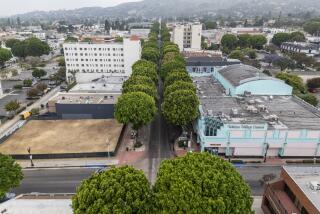Shade Lovers Rally Around Embattled Sidewalk Ficus Trees
- Share via
Shade tree lovers are trying to ax a growing campaign by Hollywood civic leaders to get rid of hundreds of ficus trees they claim are uprooting the Hollywood Walk of Fame.
The showdown has been budding for more than five years, since 31 curbside ficus trees were chopped down by the Metropolitan Transportation Authority as part of the Hollywood Boulevard subway project.
Ficus trees came under attack again last year when Hollywood Chamber of Commerce leaders blamed the street trees’ roots for damaging marble terrazzo sidewalk stars honoring Elvis Presley and other celebrities.
Two weeks ago, Walk of Fame committee President Johnny Grant announced a $250,000 repair effort for damaged stars and disclosed that his group hoped to replace the boulevard’s ficuses with palm trees.
And on Monday, city consultants said they’ll recommend that the 35-year-old ficuses be removed and a mixture of palms, evergreens and slower-growing trees planted in their place.
But supporters of the boulevard’s ficuses are digging in their heels to save the densely canopied trees.
“The shade, the oxygen--the air conditioning they provide--far outweighs the problem of root damage,” asserted Leslie Diller Zollo, a Hollywood artist and activist.
“These trees are survivors: We’ve had severe droughts in L.A. and they have needed no watering whatsoever. It makes no sense to put new trees in when we already have them.”
Boulevard business owner Aaron Epstein was a member of of the Hollywood Property Owners Assn. in the early 1960s when that group helped persuade Los Angeles officials to plant the ficus trees.
“Until then, we had no trees. The boulevard looked like a concrete jungle. We chose the ficus because you have greenery 12 months a year and they are not expensive to maintain,” Epstein said.
Thirty years later, the boulevard’s ficuses have grown high enough that their branches don’t hide shopkeepers’ signs but do offer cooling shade to pedestrians on the sidewalk, he added.
The proposal to replace the ficuses will be forwarded to the city’s Planning Department and community redevelopment agency later this month.
“A combination of evergreen and flowering trees would be placed at corners, close enough together to provide shaded transit stops. The palm trees will be in mid-block in the main Walk of Fame areas,” said city consultant Lauren Melendrez, whose downtown-based Melendrez Babalas Associates is preparing the boulevard conceptual plan under a $130,000 city contract.
Money to pay for the new trees will have to be found before the project can occur, Melendrez said Monday. And public hearings will be required before the ficus trees are removed.
“The ficus trees really are causing problems,” she added. “In the ‘60s everybody thought they were the miracle tree--leafy, little water, grow anywhere. But they tend to have large roots.”
That assertion is backed by others who have become disenchanted with ficuses. In Brentwood, ficus roots have lifted sidewalks 18 inches, convincing property owners that they must be removed.
Officials hope to replace them with flowering chantaclair pear trees, Jon Byk, president of the Brentwood Village Assn., said Monday.
Ficus fans contend that cracks on the Walk of Fame have been caused by ground subsidence created by MTA subway tunneling, which has been blamed for a myriad of problems in the neighborhood in past years.
“The damage you see is all due to the Metro Rail project. It sank nine inches here,” said Don Lippman, a 30-year Hollywood property owner, as he pointed to uneven terrazzo sidewalk panels in the boulevard’s 6700 block. “It’s still sinking. It’s going to be sinking another 20 years.”
Chris Shabel, a marketing executive who has lived in Hollywood more than two decades, said the palm tree idea is particularly poor.
“When the MTA cut down the ficuses by the Pantages theater they planted palms in their place. They look like matchsticks on the street--it’s outrageous,” Shabel said.
But the Chamber of Commerce and its Walk of Fame leaders aren’t the only palm supporters, according to Los Angeles city officials, who find themselves in the middle of the dispute.
The 240 property owners who make up the Hollywood Entertainment District, a self-taxing business improvement group, endorses palms interspersed with shady areas, said Kerry Morrison, the district’s executive director.
But the property owners are urging caution in selecting the three varieties of shade trees to be clumped at corners, Morrison said Monday.
Roxana Tynan, economic development deputy to Hollywood-area City Councilwoman Jackie Goldberg, said the mix of shade trees is still to be determined. But one tree is likely to be missing: the jacaranda.
A two-block, $5-million boulevard test project east of Cherokee Avenue that combined palms with jacaranda trees has prompted complaints that the purple-flowering tree is messy and its fallen blossoms dangerously slippery, she said.
Tynan said the reaction of those attending three public workshops where the ficus tree replacement was discussed has been positive.
“The consensus of the 35 or 40 who attended each of the meetings was for a mixture of shade trees and palm trees,” Tynan said. “There would be at least the same number of trees as exist now.”
The cost of the tree-replacement is uncertain. Money might be available from a combination of sources, including federal funds, Tynan said.
Protests could kill the palm plan, however.
“Our only interest is in reflecting what the majority of people want,” Tynan said. “If the majority want to leave the ficus, we’ll leave the ficus.”
Ficus supporter Paul Zollo, a Hollywood writer and musician, predicted that will happen if others take a close look at the benefit that the shady ficuses offer the boulevard.
“Whether or not people care about the inherent value of trees and their beneficial qualities, removing existing trees only to replace them with other trees is a serious waste of taxpayer money,” said Zollo.
More to Read
Sign up for Essential California
The most important California stories and recommendations in your inbox every morning.
You may occasionally receive promotional content from the Los Angeles Times.











